Location: Nishigawa, Nikko-shi, Tochigi
Date of interview: 10/02/2010
The only dams I have seen under construction are the Kosatogawa Dam and the Tokuyama Dam, but I had never seen construction in full swing, and there are many major dams in this area, so I was determined to tour them together (laughs).
The Yunishigawa Dam is a multi-purpose dam to be constructed on the Yunishigawa River in the Tone River system. When completed, the dam will have a crest height of 119 m, a crest length of 320 m, and a total storage capacity of 75,000,000 m3. Even just looking at the numbers, I am excited and nervous.
By the way, this is the first photo in this article that was taken with a Canon EOS 60D. Oops, that was unimportant information.
Entrance to Yunishigawa Dam main body construction JV construction office

The meeting place is the JV construction office, but I don't tell you that I almost went to the Ministry of Land, Infrastructure, Transport and Tourism's construction office by mistake. It was just like a scene from a certain construction site... I also saw a newly built house on the hill at the back of the building, but I wonder if it is a house that was moved here due to the flooded area.... Sorry, I have not confirmed this.
The time was 9:30 in the morning. The meeting time was 10:30 a.m., but we arrived at Imaichi Dam at 6:00 a.m., ate breakfast at Nakaiwa Dam, an arch dam curry supervised by dam maniacs that was on sale at the Save On convenience store near Nikko Edomura, and visited Koami Dam and Gojuri Dam before we arrived. I was not only full from the dam curry, but also my heart was already full from the dam.
Incidentally, at the Gojuri Dam, there was a person who was taking a lot of pictures with a camera! I thought, "Are you going to Yunishigawa? I asked him if he was going to Yunishigawa, and to my surprise, he was right!marcic acidHe was a person named "Kurobe". Since it was our first meeting, he seemed to be quite suspicious of me (laugh), but we later decided to work together at Mikawasawa Dam and Kurobe Dam (Tochigi).
Signboard at the entrance of the Yunishigawa Dam main body construction JV construction office

This is another sign you see often.
Panoramic view of the Yunishigawa Dam main body construction JV construction office

The office is huge. I guess the building on the right is where the construction workers sleep. Sorry, I have not confirmed this yet.
Building a Dam is Building a Dream

While I was surprised at the size of the office, I could not help but be moved by the catchphrase, "Building a dam is dream building. I can imagine everyone working with pride.
Front facade of the Yunishigawa Dam main body construction JV construction office

Now, it's time to enter the office. I feel strangely nervous.
Yunishigawa Dam main body construction JV construction office, conference room

This is a large conference room. It would be spectacular to have a meeting here.
KY Activities

What caught my attention in the conference room was this poster. It is not an "air-reading activity." It is a "Hazard Prediction Activity.
Yunishigawa Dam main body construction (construction outline)

These are the materials given to you this time. Based on these materials, you will receive an explanation of the main construction.
Helmets, military gloves, safety jackets

After a brief greeting in the office, we put on our helmets, military gloves, and safety jackets. I was a bit confused as I was putting on the safety jacket for the first time, but it is not that difficult as it has Velcro tapes.
Travel to the site in an old Delica

The construction site has many rough roads, and a 4WD 1BOX would be necessary to drive there and carry a good number of people. However, the following vehicles are station wagons. Most of the vehicles at the construction office were station wagons.
View of Batcher Plant

There is a tremendous noise. It sounds like construction is underway! It is like "construction is in full swing!
View of the main body of work from the high ground on the downstream side of the right bank
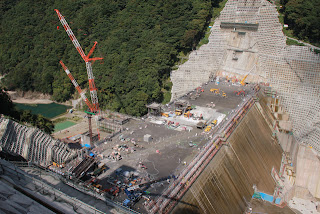
Move to the viewing platform set up on the right bank. From there, you can see the construction work. Not only the workers but even the heavy machinery looks like small miniatures. That is how huge the dam is.
The project is scheduled for completion in 2011, three and a half years after construction begins, and we saw work proceeding at a rapid and safe pace.
Explanation by Mr. Ouchi of Kajima-Shimizu JV (Part 1)

We will see this construction with an explanation by Mr. Ouchi of the Kajima-Shimizu JV.
Explanation by Mr. Ouchi of Kajima-Shimizu JV (Part 2)

In addition, a panel larger than a person's height was installed in the back of the room, and this panel was also used for explanations.
concrete bucket

Above us, concrete buckets were going back and forth several times. I have only seen this on video, but seeing it live is a very powerful experience.
Temporary drainage tunnel entrance

The other side of the dike can be seen on the other side of the dike.Temporary drainage tunnelThe concrete of the tunnel is brand new and clean. The concrete of the tunnel is brand new and clean. And can you tell how big it is by comparing it with the microbus in the foreground?
Dump trucks and bulldozers
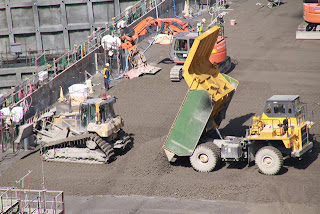
Heavy machinery is also moving around incessantly. They must be huge if you see them up close. Unfortunately, we were not able to see them up close this time.
Road roller (Vibration roller)

The main body work is done by the RCD method, a method originally used for airplane runways and roads, which is applied to dams, and heavy machinery similar to that used for road construction is used. This road roller is one such machine.
Joint cutter

The purpose of this joint cutter (joint cutter) is to intentionally place joints on the surface of concrete to reduce the occurrence of cracks. Without joints, freshly placed concrete will heat up and dry out easily, which can lead to cracking.
Workers cooling concrete

As mentioned earlier, freshly placed concrete generates heat and dries out. This is the cause of cracks, so cooling is necessary.
View of the downstream side of the dike from the high ground on the right bank

It is a little hard to see, but it is an exciting downstream surface that will create a completely different atmosphere after completion.
View of the sub-dam from the high ground on the right bank

Well, it's still hard to tell from here.sub-damI'm sure we will see it later. I will have to see it later from directly below....
left bank (slope)

Lots of waffles (laughs) The area where there are no waffles is where the dike will be built. You can also see the cable crane being driven into the top of it. Also, it's a little hard to tell from this picture, but the blue and white panel in the center of the left side of the slope represents the full water level at all times.
Dike Hopper

This is an "embankment hopper," a machine that receives the concrete dropped from the concrete bucket and feeds it to the dump truck.
Concrete is fed from the bucket into the dike hopper.

This is a shot of concrete being dumped from the concrete bucket into the embankment hopper. If we were to describe it in sound, it would be "zusaa".
Belt conveyor loading concrete transported from SP-TOM onto dump trucks

This is a conveyor belt connected to the SP-TOM, a transport machine capable of transporting concrete and other materials even on steep slopes. In other words, concrete is transported by two 15.0-ton cable cranes and one SP-TOM.
Concrete bucket and dump truck

Sometimes the concrete is fed from the concrete bucket into the embankment hopper, sometimes directly into a dump truck.
Cooling downstream of the dike

Here, too, you see water being poured over the concrete to cool it. The red frame in the photo is the formwork for the joints.
Move to batcher plant

Next, move on to the batcher plant. In single file in order.
Concrete bucket becomes service hopper

This is a view of a concrete bucket being transported by a cable crane to a service hopper.
Climb the stairs...

Now, the next step is to watch the pouring from above. We will climb the stairs in a gaggle.
Cable crane operation room

This is the operation room of a cable crane. The crane is almost completely automated and is never moved manually.
View of the main construction from the right bank

From here, it is almost the center of the levee and the dam axis. In reality, it would be a little more to the left.
transfer car

This is the transfer car that carries the concrete from the batcher plant to the concrete bucket. When the concrete bucket has not arrived at the service hopper, it waits once in front of it. This is all automatic.
Transfer car moves to service hopper

When the concrete bucket arrives at the service hopper, the transfer car moves to the service hopper.
Concrete is fed into the bucket from the transfer car

The concrete is then put into the bucket. Can you see the concrete that was in the upper mouth is gone? If we were to describe this with a sound, it would be "zusaa".
Empty transfer cars are back.

Then, after finishing feeding the concrete bucket, the transfer car returns to the batcher plant. This is repeated over and over again.
When the transfer car returns, concrete falls from above.

As the transfer car returns to the batcher plant, concrete is fed into the transfer car from above. Here it is more like a thud, perhaps because I heard it up close rather than a zusher.
Boom, boom, boom from above.
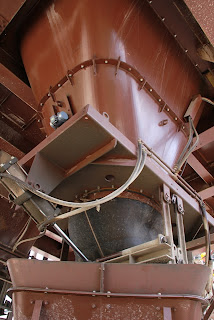
At this time, a thumping sound is heard.
There's an aggregate plant just over here.

The aggregate plant is located on the other side of this building and will be moved there.
Aggregate Plant

Compared to the pouring site, it is quite quiet. If the pouring site is "moving," this aggregate plant is "quiet. However, concrete is being produced.
Can be stored in storage tanks.

Aggregate is stored in a storage tank.
There's a batcher plant just over here.

From the aggregate plant, the material is transported in a series of conveyor belts to the batcher plant.
Incidentally, aggregate is quarried from the Yunishigawa River area and the Kinugawa River, unlike in the past when it was collected by scraping the mountains. Therefore, you will see signs posted at various locations saying "We are collecting aggregate from the Yunishigawa Dam.
View of the main construction from downstream
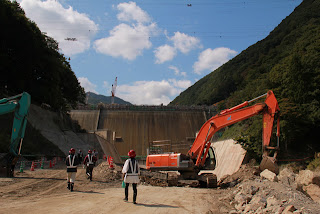
Next we will look at the main body of work from downstream. The place where we are now is the place where we will no longer be able to stand when the project is completed. I am deeply moved when I think about it. I wonder if both sides of the river will be maintained so that visitors will be able to see the work. I really hope so....
View of the levee from downstream

This is another place where you will never be able to stand once it is completed. I have looked up at the existing dam from downstream several times, but this is the first time I have looked up at a dam under construction. This is an angle that I will probably never be able to capture again.
View of the right bank conduit wall

The right bank side is probably where the discharge facility will be installed. There is a cutout at the top and a hole for a valve on the wall. Probably, it is a hole for river maintenance discharge. (Or, since the JV is there, you should ask them!)
View of the left bank conduit wall

It was a beautiful concrete that had just been poured, but the color was a bit pinkish, which was strange.
View of the sub-dam

This is the sub-dam we were looking down on from above earlier, but is it my imagination that it somehow looked smaller than it did from above....
conduit gateTemporary drainage channel in the dike for secondary diversion

This is a conduit gate used as a permanent flood discharge. The gate is covered by a cloth and its details are not visible.This is a temporary drainage channel in the dike for secondary diversion. It will be filled with concrete when completed. (Thanks!)
Spoiler attached to the left bank side dike

Perhaps it is a spoiler with the intention of reducing forces. (That's why I said to check.)
Formwork for joints

The formwork looks as if it is protective.
Embankment surface

Suddenly I wanted to photograph the surface of the concrete. I took a close-up of it. The water flowing for cooling covers the concrete, and it looks strangely beautiful.
Temporary drainage tunnel exit
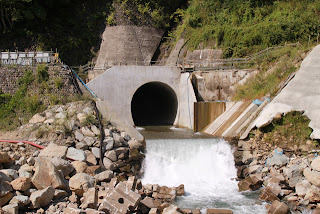
Moving a little downstream, the exit of the temporary drainage tunnel opens its big mouth.
crane

Next we move to the upstream side, where we will be submerged in a dammed lake in the future. Autumn, when the sky is high and the horses are fat. The crane seems to pierce the azure sky.
View of the embankment from the dam lake side

Once the embankment is completed, this area will be sunk as a dammed lake, so this angle will never be seen again.
conduit gate tapsTemporary drainage channel in the dike for secondary diversion

conduit gateThis is a temporary drainage channel in the dike for secondary diversion. I guess we won't be able to see this either!
View of the right bank from the dam lake side

Look up at where we were just now. The low building at the far end of the right bank is where we were first briefed. The brown building in the middle is the batcher plant where we were explained next. By the way, this scene looks good with blue sky.
Batcher plant and service hopper

Further up the right bank. Anyway, it works well. Concrete buckets come and go.
temporary breakwater

And where you are standing now is the secondary deadline.weirThe primary weir is the one in the photo. The primary cutoff weir is the one in the photo. The secondary one is larger in scale, but I inadvertently failed to photograph it...
A barrier weir is a dam that temporarily stops the main flow of a river, without which the site would be submerged during construction. Without this dam, the site would be submerged during construction. Also, if only a barrier weir is used, a dam lake would be created, so the water is temporarily drained using the temporary drainage tunnel mentioned earlier.
It also looks like an earth dam, but it is a splendid concrete dam built by the CSG method. When the dam is flooded with water for a test, a portion of the dam is cut down and sunk as it is, eliminating the need for design or appearance. In short, it is enough if it can hold back water. But it was built with safety in mind.
selective intake tower
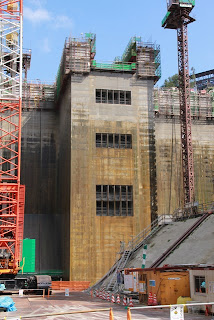
A stranger might think it is a building construction. A building with small windows.
Looking up at the concrete bucket from the dam lake side

Concrete buckets flying in the sky. It must have been a reality for those working on the site, but seeing it live for the first time, I felt as if I was looking at an unreal world.
At any rate, I was able to witness the rapid and safe progress of work at the Yunishigawa Dam construction site. This was the first time for me to see a concrete dam construction site, and I could not help but be amazed at the light of hope that scientific development is shining on dam construction.
In the anime "Aim for the Top! I couldn't help but think of that scene over and over again.
Well, that's what I thought about the tour.
interpoint (interword separation)
interpoint (interword separation)
interpoint (interword separation)
The following is a bit removed from the main construction.
View of Yunishigawa Dam Curry from the sky

After the tour, the dam association members and participants will move to "Yunishigawa" Roadside Station. The purpose of the tour is to visit "Yunishigawadam curryThis is a "Dike". Aggregate or earth or sand is scattered under the rectangular body that looks like an embankment, which is under construction. Is that heavy equipment at the top?
As for the taste...please check there. Let's just say it is not that spicy.
Amphibious bus stop at Roadside Station "Yunishigawa
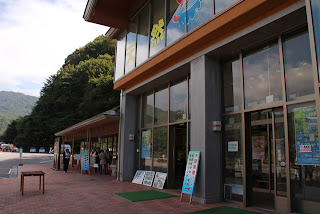
And there is an amphibious bus that departs and arrives here, and the bus will take you to Kawaji Dam (0571-Kawaji Dam/Kawaji Dam). In addition, they can walk to the catwalk at Kawaji Dam! You have to make a reservation, but I was too lazy to do the research beforehand, so I did not make a reservation and did not take the bus (I heard it is possible to take the bus if seats are available on the day of the tour). (I heard that it is possible to ride the dam if seats are available on the day of the tour.) There were other dams I wanted to visit...
amphibious bus

The amphibious bus has "Yunishigawa Dam and Dam Exploration Duck Tour" written on its body. The tour is actually a visit to the Kawaji Dam, but when the Yunishigawa Dam is completed, the tour will include a visit to the Yunishigawa Dam. Personally, however, I would like the Kawaji Dam tour to remain as well.
Amphibious bus screw

It is a bus, but it also runs on water, so naturally it has screws. It is smaller than I expected. I wonder if the pace is slow. The amphibious bus costs 3,000 yen for adults, and reservations can be made online. For details, see "Yunishikawa Duck Tour official websitePlease refer to the "See
dam characteristics
| River Name | Tone River system Yunishigawa |
|---|---|
| Objective | Flood control, agricultural disaster prevention, unspecified water, river maintenance water, irrigation water, water supply water, industrial water |
| Model | gravity-fed concrete dam |
| Bank height | 119m |
| Bank length | 320m |
| Dam volume | 1,020,000m3 |
| Watershed Area | 102km2 |
| Reservoir area | 198ha |
| Total storage capacity | 75,000,000m3 |
| Effective water storage capacity | 72,000,000m3 |
| Dam operator | Kanto Regional Development Bureau |
| Main body constructor | Kajima Corporation, Shimizu Corporation |
| Year of launch | 1982 |
| Year Completed | 2011 |
Other facilities/observations
It is still under construction, so it is unclear how it will turn out, but since it is a large scale, multi-purpose dam for the Ministry of Land, Infrastructure, Transport and Tourism, I am sure that the facilities for visitors will be enhanced.
| Parking lot | ? |
|---|---|
| Toilet | ? |
| Park | ? |
| PR Exhibition Hall | ? |
| Fishing | ○ |

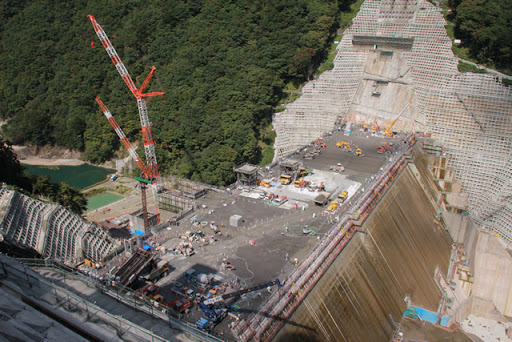

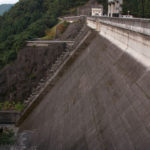
Comment